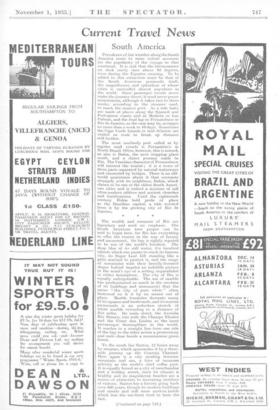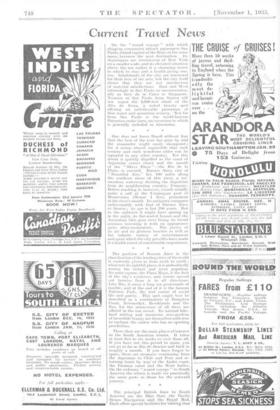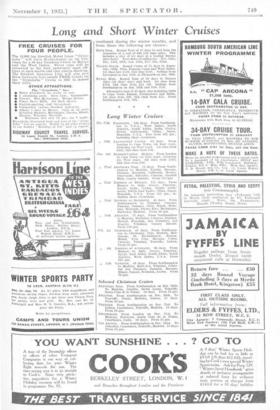Current Travel News
South America
Prevalence of fair weather alongthe South America route to some extent accounts for the popularity of the voyage to that continent. It is said that the thermometer on deck rarely rises abovo 80 degrees, even during the Equator crossing. To In added to this attraction must be that of the South Ainerican peninsula itself, the magnificence and splendour of whose cities is unrivalled almost anywhere in the world. Since passenger vessels never snake the journey direct, it need never prove monotonous, although it takes two to three weeks, according to the steamer used, to reach the nearest port. As a rule halts are made at places along the Spanish and Portuguese coasts and at Madeira or LOIS Palmas, and the final lap to Pernambuco or Rio do Janeiro, as the case may be, averages no more than a week to 10 days. Sometimes the Cape Verde Islands in mid-Atlantic are visited en route to break up distance still further.
The most northerly port called at by regular mail vessels is Pernambuco in North Brazil. Often, however, this is missed, as also is Bahia, the next stopping place south, and a direct journey made to Rio. The Venetian character of Pernambuco will interest the tourist ; it is a town of three parts separated by natural waterways and connected by bridges. There is an old- world quaintness about it that contrasts strangely with its neighbour, Bahia, which claims to he one of the oldest South Ameri- can cities and is indeed a mixture of tall ultra-modern edifices and ancient, churches and fortifications. 1; it the eighteenth century Bahia hold pride of place as the Brazilian capital, a title wrested from it by the growing city of Rio de Janeiro.
* * a
The wealth and romance of Rio are legendary and need no emphasis. The South American tour proper can be said to begin here, for Rio has everything to oiler the tourist in the way of luxury and amusement. Its bay is rightly reputed to be one of the world's loveliest. The deep blue of its still water, tl e hundred islands which one passes to reach its famous city, its Sugar Loaf hill standing like a grim sentinel to protect it, and the range of mountains with their heavily-forested 'lopes behind imprint an indelible picture in the mind's eye of a setting unparalleled in either hemisphere. The city of Rio is equally unforgettable. The use of marble has predominated so much in the erection of its buildings and monuments that the name " the city of pure white " often bestowed on it is by no means out of place. Marble fountains decorate many of its squares and boulevards, and its marine promenade is an un bru ken stretch of white marble extending to a distance of five miles. Its main street, the Avenida. Rio Branco, vies with the Champs ElyeaSes and the linter don Linden as the- most picturesque thoroughfare in the world. It reaches in a straight line from one side of the bay to the other across a promontory and ends close beside a mountainous green forest.
To the south lies Santos, 12 hours away by steamer, which approaches it by a three- mile journey up the Caiaruja Channel. Hero again is a city nestling between mountain and sea, a hive of immense activity as the world's chief coffee port. It is equally famed as a city of merchandise and a holiday resort, since its climate is healthy and its magnificent beaches are a source of attraction to increasing numbers of visitors. Santos has a history going back over 400 yeari. though, its modern buildings and streets and still more modern hotels which' line the sea-front tend to belie the fact.
(Continued on page 748.) Current Travel News
On the "round voyage " with which shipping companies. attract passengers Sao Paulo, inland capital of the State of the same name, becomes the next destination. its skyscrapers are' reminiscent of New • York on a smaller scale, and its elevated situation above the sea makes it a charming resort in which to stay and a health-giving one, too. Inhabitants of the city are renowned for their love of the arts, but the city itself shows that they are not unconscious of material satisfactions. East and West intermingle in Sao Paulo as uneonvention: ally as they dO m Cairo or Singapore.' Tourists to Sao Paulo from Santos will not regret the 3,000-feet climb of the Alto de Serra, a noted beauty spot offering an unbelievable panorama of blue water and mountain scenery. Not far from Sao Paulo is the world-famous Butantan snake farm, an excursion to which is generally included in itineraries.
One does not leave Brazil without fear that the best of the tour has gone by and the remainder 'might easily disappoint ; for it seems almost impossible that such scenery and such wondrous cities can be repeated in any other country. Yet this doubt is quickly dispelled as the coast of Argentina conics closer and the mouth of the "Silver River "—the Rio de la Plata--is entered. Buenos Aires, city of " Beautiful Airs," lies 100 miles along the southern shore of this river, a tre- mendous waterway dividing the Argentine froth its neighbouring country, Uruguay. Before reaching it, however, vessels usually make a call at the Uruguayan port of Montevideo (Mount I Sue), prominent at the river's mouth. Its antiquity compares unfavourably with that of Buenos Aires or Santos ; its age is but 200 years. But to the sightseer it might have sprung up in the night, its flat-roofed houses and the Australian blue gum trees lining its broad avenues investing it with an appearance
quite ultra-modernistic. The purity of its air and its glorious beaches as well as the infinite variety of entertainment and sport which the city provides have made it a health resort of considerable importance.
* * *
The position of Buenos Aires in the classification of the leading cities of the world is variously given as from sixth 'to ninth whatever its rightful place, it is undoubtedly among the • richest and most populous. Its main square, the Plaza Mayo, is the hub of the city's existence, and streets spread Out fanwise from it in all directions. Like Rio, it owns a long sea promenade of Marble, and at the end of it is the famous Palermo Park, the " real centre of social life and gaiety. .This' spot, might best be described as a combination of Hampton Court, Newmarket, Brooklands and the Zoo, for the attractions of all these are offered in the one resort. Its natural lake- land setting and enormous rose-gardens of incredible beauty are themselves sufficient to enchant the visitor who has no sporting proclivities.
These then are the main places of interest to the South American tourist, It takes at least five to six weeks to visit them all. if you have not this 'period to spare, you can go as far as Rio do Janeiro and back in roughly a month. If you have longer to spare, there are steamers continuing from the Argentine to Chile and Peru and re- turning barrio by way' of the Andes coast, the Pariainit canal and the West Indies., On the ordinary " round voyage " to South America the return is made via practically the same ports as those for the outward journey.
* * *
The . principal British lines to South America are the Bine Star, the Pacific 'Steam Navigation and the Royal Mail. Each offeiS Special facilitieifor Visiting that
Long and Short Winter Cruises
continent during the winter months, and from these the following are chosen : BLUE STAn. Round Tour of 47 days to and from the Argentine at a cost of £08 (1st class only). This includes a stay of six days at a leading Buenos Aires hotel. Next dates of sailing are Nov. 23rd, Dec. 14th, 28th, San, 18th, Feb. 8th, 22nd.
PACIFIC STEAM. Round Cruise of 75 days to Argen- tine, Chile, Peru, Panama Canal and West Indies. 1st class fare £140, '2nd class £105. Sailing° from Liverpool on Jan. 15th, or Plymouth on Jan. 16th.
ROYAL MAIL, Round Tour of 38 days to Buenos Aires (ak days' stay) and hack, let class from £110, 2nd class from £55 10s. Mailings from Southampton on Jan. 24th and Feb. 21st.
Alternative tour of 45 days, also including visits to Cape Verde Islands, Pernambuco and Bahia. 1st class from £92, 2nd class from £35. From Southampton Feb. 8th.




























































 Previous page
Previous page